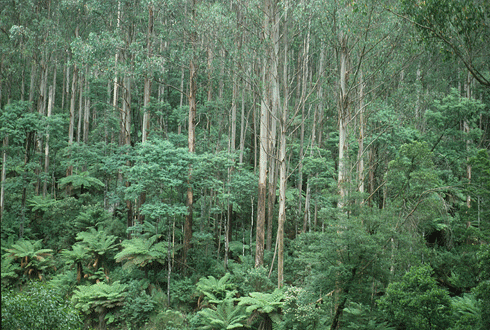
|
Published: 5 November 2012
Do Australia's giant fire-dependent trees belong in the rainforest?
Australia's giant eucalyptus trees are the tallest flowering plants on earth, yet their unique relationship with fire makes them a puzzle for ecologists. Now the first global assessment of these giants, published in New Phytologist, seeks to end a century of debate over the species' classification and may change the way it is managed in future.

|
|
Young mountain ash saplings in at the edge of temperate rainforest in Tasmania. Credit:
CSIRO Publishing
|
Gigantic trees are rare. Of the 100,000 global tree species only 50, less than 0.005 per cent, reach over 70 metres in height. While many of the giants live in Pacific North America, Borneo and similar habitats, 13 are eucalypts endemic to Southern and Eastern Australia.
The tallest flowering plant in Australia is Eucalyptus regnans, with temperate eastern Victoria and Tasmania being home to the six tallest recorded species of the genus. One Tasmanian tree was measured at 99.6 m, while a tree in Victoria achieved the historic record of 114.3 m.
‘The conifers of North America are often thought of as the largest trees on earth, yet the flowering eucalyptus trees of Australia reach comparable heights,’ Professor David Bowman, from the University of Tasmania's School of Plant Science.
‘This is surprising as Australia is the world's driest inhabited continent. Yet, this apparent paradox may explain the evolutionary advantage of gigantism in trees.’
Wildfires are common in dry and arid environments such as Australia, but Eucalyptus regnans has evolved a unique dependency on fire for regeneration.
While fire may kill the trees, their seeds are protected in aerial capsules, which are then released on to the scorched earth. The fire not only clears away potential seed predators and any forest canopy which may block sunlight; it also releases nutrients in the soil which encourages seed growth.
‘This unique relationship with fire helps us understand how these giants evolved,’ said Bowman. ‘Our research suggests gigantism in eucalypts evolved opportunistically within the last 20 million when the ideal environmental conditions for rapid tree growth were combined with the presence of wildfire.’
However, fire dependency now threatens the trees' future as much as it has shaped their past. Due to this trait, foresters classify the tree as a unique type of Australian vegetation, rather than considering it a rainforest tree.
‘This classification has serious scientific and conservation implications for the remaining forests of mature (old growth) giant eucalypts,’ said Bowman. ‘Giant trees have huge value for the timber industry, yet there are strong environmental reasons for their protection. Classification as rainforest trees would support arguments in favour of conservation.’
Dr Bowman's team presents a comparative analysis clarifying the relationship between the giant eucalypts and other rainforest species. Their findings suggest that while the species has evolutionary advantages that allow it to outcompete other species, they do coexist on the margins of rainforests and should be considered part of that ecosystem.
‘Our work seeks to resolve a century old dispute about rain forest classification,’ concluded Professor Bowman. ‘Rather than seeing them in isolation we place these giants into their global context by recognizing them as species of rainforest tree, albeit trees with a unique dependence on fire.’
Source: EurekAlert!



